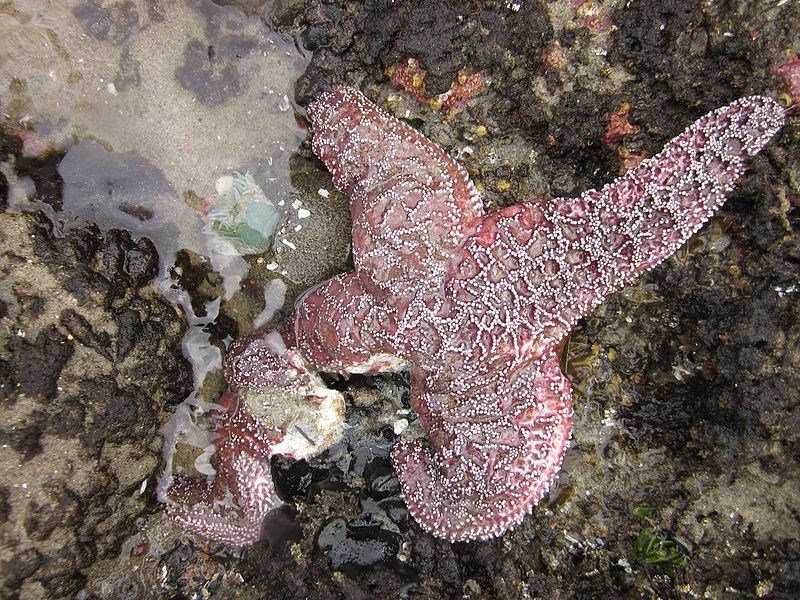We have better maps of Mars than of the ocean floor. We know more about the moon than the critters that live deep under water. It is, in many ways easier, to observe stars in the distant galaxy than to study sea stars in their natural environment.
During the last half decade, while the sun, moon and stars above predictably tracked the seasons and years, stars below the sea winked out in one of the largest marine wildlife die-offs in modern history. Sea-star wasting disease — a name that encompasses disease and environmental factors — wiped out 80 to 100 per cent of some sea star species along the west coast of North America.
Before 2013, the coast was home to more than 30 species of sea stars — star-shaped echinoderms belonging to the group of animals called “asteroids” (“star like”). Many-limbed sunflower stars and five-armed purple, ochre and red sea stars carpeted areas of the sea floor in the intertidal zone up and down the coast, from Alaska to Mexico, while their relatives lived in deeper waters.
But that summer, many started wasting away. They developed skin lesions. Their limbs dropped off. They spilled their guts. They dissolved into goo.
Often, the only remains of a once-healthy sea star were disconnected limbs, blobs of mush, and piles of the white, calcified fragments that formed their skeletons.
The once-common sunflower star, Pycnopodia helianthoides (dense-footed sunflower-like), is now locally extinct across most of its range. The disease was almost as disastrous for the purple or ochre sea star, Pisaster ochraceus, also common before the disease struck. One study found 81 per cent Pisaster mortality between 2012 and 2015.
A virus has been identified as the cause of the disease, but researchers believe other factors contributed. Exceptionally warm ocean conditions along North America’s west coast in 2013 — 2015 might have triggered the outbreak or helped it spread.
And while the virus spelled disaster for Pisaster, sunflower stars, and other species, other species have been less affected. Mottled sea stars, for example, take longer to become infected but die faster once sickened. Overall, fewer mottled sea stars died from the disease in local waters off Vancouver Island than did their main sea star competitors, Pisaster ochraceus.
For other species, scientists say drought, pollution, and bacteria might have played a role.
One thing is clear, the uncontrolled natural experiment has helped clarify the roles sea stars play in the marine ecosystem.
Indiscriminate and often aggressive predators, many sea stars feed on molluscs, sea urchins and even each other. Drop some sunflower-star juice into a tank of sea life, for example, and sea-floor critters will recoil and scramble out of the way as best they can, enacting a certain Monty Python scene — “Run away. Run away” — in slow motion. Scallops will shoot across the aquarium to avoid the juice, cockles will flip their shell over and away, abalones will twist and will move away, and sea urchins — the sunflower star’s preferred prey — will scuttle away ever so fast for urchins.
Without sunflower stars scaring the squirts out of seafloor life and chowing down on sea urchins, near-shore ecosystems change. In just a few years without sunflower stars, sea urchins have mowed kelp forests down in Burrard Inlet, off California, and elsewhere along the coast, creating seafloor deserts called urchin barrens.
Pisaster also feeds on urchins, but seem to prefer mussels. With natural Pisaster brakes removed from mussel expansion in shallow waters, mussels take over, crowding out other seafloor species. In addition, without Pisaster dominating the playing field, the rarer mottled sea stars are now more abundant in the intertidal zone.
Numbers might be stabilizing among the species most affected by sea-star wasting disease. What the die-off’s long-term effects will be remains uncertain. Genetic analyses of the affected sea-star species show an enduring genetic shift among the survivors, indicating the die-off created a genetic bottleneck. The survivors might be genetically more resilient to the virus and the other factors that caused the sea-star collapse.
Perhaps a new breed of super sea star will emerge from the disaster, and researchers will have a new asteroid to track and study beneath the waves.



